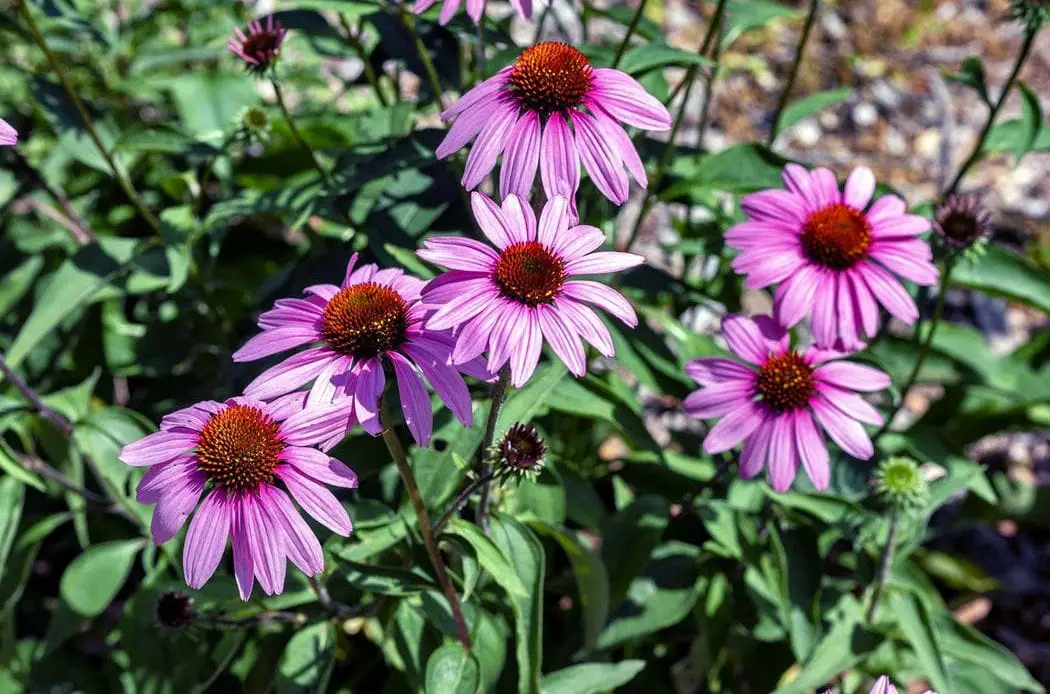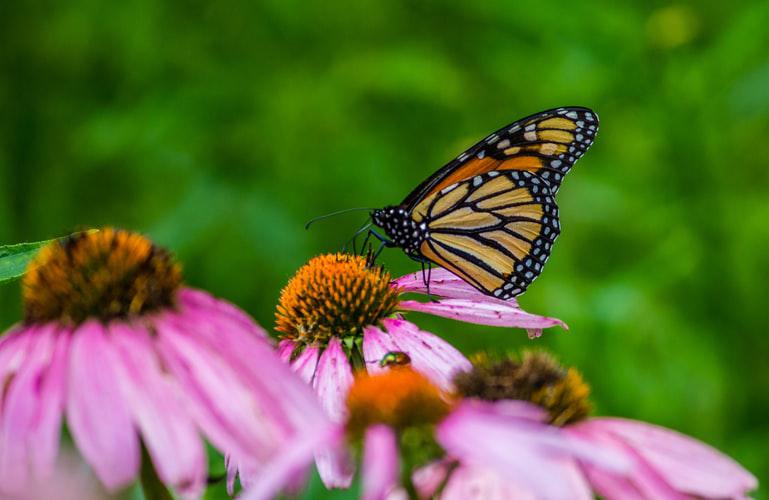
Flowers offer endless inspiration to anyone who seeks to be enlightened. Given their beauty, their color, and the way they lighten the heart, anyone would like to put together a garden. Are you one of them? Having a garden is an opportunity to peek into the world of flowers and understand how each flower is unique. Every species of flower is different from the other and belongs to a particular family, like the coneflower, one of the most beautiful flowers in the world.
Introduction to coneflower
Scientifically recognized as Echinacea, coneflowers are a group of herbaceous flowering plants. They belong to the daisy family and are found in eastern and central North America. They are perennials and they fare well in moist to dry environments and open wooded areas. They grow in grasslands, dry woodlands, fields, meadows, and prairies. These flowers have large showy heads made of composite flowers and they bloom the entire summer. Due to their spiny central disk, their generic name Echinacea is derived from the Greek word ‘ekhinos’ which means ‘sea urchin.’
Ten different species belong and are commonly called as coneflowers and include
- Tennessee coneflower
- Narrow-leaf coneflower
- Wavyleaf purple coneflower
- Sanguine purple coneflower
- Pale purple coneflower
- Smooth coneflower, smooth purple coneflower
- Narrow-leaved purple coneflower
- Yellow coneflower, Bush’s purple coneflower
- Topeka purple coneflower
- Purple coneflower, eastern purple coneflower
Unfortunately, the Tennessee coneflower and the Yellow coneflower are among the endangered species. As per researchers, there are nearly 40 echinacea or coneflower that are genetically diverse. While some of these species are cultivated as showy flowers, others have a different purpose, like the purpose coneflower.
Purple coneflower
The purple coneflower is scientifically known as Echinacea purpurea. They have a flowerhead that is shaped like a cone and is surrounded by white or light purple petals-like rays. These flowerheads are 6.5 to 10 cm in width and are radially symmetrical. The flower that blooms has a spiny central cone that is surrounded by bristle-tipped petal-like rays that are drooping downwards, and grow from the under portion of the cone.
The purple coneflower are relatively large flowering plants that are 30 to 150 cms in height. They have a coarsely textured robust stalk that have leaves with a rough texture and long petioles. The leaves of this plant are narrow and oval-shaped that have a pronounced and tapered end.
The most popular purple cornflower cultivar includes:
- The Magnus purple coneflower with giant rosy-pink flowers.
- The Avalanche purple coneflower, a white ray petal-like flower that has yellow-green center cones.
- The White Swan purple coneflower that dons white blooms
- The Greenline purple coneflower with white ray florets and emerald green central cone.
- The Fragrant Angel purple coneflower with white overlapping rays and yellow-orange central cone.
- The Green Envy purple coneflower with green rays that have a ring of magenta.
- The Double Decker purple coneflower with unique, two-layered pink blooms.
The description of this flower is just enough for a gardener to plant one. But did you know that there are some interesting purple coneflower facts that can get anyone interested to know more about these beautiful flowers?
Interesting purple coneflower facts!
Of the ten recognized species of the coneflower, the purple coneflower is considered to be the most sought-after flowering plant by gardeners. The plant does not just produce one of the most beautiful flowers in the world, but it also offers other benefits and some great facts that can get you thinking. Here are the interesting purple coneflower facts!
- The flowering plant is a part of the Echinacea genus and Asteraceae family.
- Echinacea tennesseensis, Echinacea simulata, Echinacea sanguinea, Echinacea purpurea, Echinacea paradoxa, Echinacea pallida, Echinacea laevigata, Echinacea atrorubens, and Echinacea angustifolia species are referred to as purple coneflowers.
- Some of these species of purple coneflowers are known for their hue that is a vibrant purple, as well as their bright foliage.
- The purpurea in the species name ‘Echinacea purpurea’ stands for purple.
- It is also known as eastern purple coneflower, hedgehog coneflower, snakeroot, Kansas snakeroot, scurvy root, echinacea, Indian head, and narrow-leaved purple coneflower.
- The purple coneflower plant has a hairy and robust stem that can grow anywhere from 2 feet to 4 feet in height.
- These plants can survive up to 5 to 6 years in the wild.
- The leaves of the plant are alternatively arranged on the stalk, and they are elliptical with serrated or jagged edges.
- Each purple coneflower plant produces a single flower head on top of its stem.
- One of the most fascinating purple coneflower facts is a phenomenon known as allelopathy. The coneflower produces and secretes chemicals to prevent the growth of competing plants.
- These flowers are odorless when they bloom. What is interesting is that these odorless blooms emit honey-like scent when the ray florets orient themselves downward. The sweet scent attracts pollinators. What is more interesting is that a purple coneflower emits a sweet, vanilla-like scent after pollination.
- Bees and butterflies are the pollinators of purple coneflower. The color attracts these pollinators and hence you will find butterflies and bees swaying around the flowering plant.
- Did you know the purple coneflower attracts songbirds in addition to bees and butterflies?
- The flowering plant blooms from June right up till September making the garden look fresh and lively throughout the season.
- Their flowerheads consist of nearly 200 to 300 florets. These florets are arranged in the form of a spiny cone that is in the center. The cone is surrounded by fifteen to fifty petal-like rays.
- The spiny cone of the flowerhead is referred to a sea urchin as it looks like one.

- The purple coneflower produces a fruit that is dry and single seeded cypsela, and has three to four edges.
- One of the most vital purple coneflower facts is that these flowering plants have healing capacity.
- The healing properties were discovered by the native Americans who realized its benefits after watching wild animals. They discovered its healing capacity after watching wounded elks recover after consuming the purple cornflower. This fact is also true for the other 9 species of cornflower.
- The juice extracted from the roots of the purple cornflower was used to treat several problems such as toothache, open wound, sore throat, as well as snake bites by native Americans.
- Purple coneflower was marketed as a herbal medicine for blood purification, by the Europeans. The Europeans learned about the health benefits of these perennial plants from the Native Americans and started selling them as a remedy designed specially to purify the blood.
- It was one of the most commonly used, and the most popular herbal medicine in America at the beginning of the 20th century.
- In the present times, purple cornflower is used in the form of tincture and pills as a herbal remedy to boost the immune system. It is also used to alleviate the symptoms of common cold and flu.
- Yet another vital purple coneflower fact is that modern science has proved that the flower contains a substance with anti-inflammatory and antiseptic properties. It means that the flower can prevent inflammation and eliminate germs.
Here are some more fun facts!
- There are more than 200 medicines that are derived from purple coneflower extract.
- The flower is also used to treat distemper in horses.
- The only major pest or disease that the purple coneflower has difficulty with is the Japanese beetle.
- If all flowers are left on the purple cornflower plant, they form seed heads that can result in self seeding and spread.
- You can prolong the flowering as well as prevent self-seeding by deadheading the plants.
- It is one of the most ornamental and decorated plants in the gardens now.
- Did you know that this flowering plant is deer resistant?
- The roots of this flowering plant produced a salty taste when consumed. But the plants do not like their roots to be disturbed.
- An interesting purple coneflower fact you may not have heard of is that this plant was named the ‘thirst plant’ because the roots reduced a person’s thirst and they were consumed when water was scarce.
Purple coneflower can be grown from a seed easily. The best time to sow the seed is late spring or summer at an appropriate planting site with well-drained soil. The soil must have ample sunlight. The purple coneflower flowering plants can be propagated indoors as well. All you need is a container with well-drained soil. Sow the seed at a depth of half an inch. You must ensure that the room is at a temperature between 65 to 75 degrees Fahrenheit. They can be planted outdoors after 9-10 weeks, in early fall.
The purple coneflower is a plant that has fungal pathogens that can cause diseases such as bacterial leaf spot, powdery mildew, and gray mold. These flowering plants need ample sunlight to photosynthesize and get rid of the excessive moisture that builds up to fungus. Caring for these plants is not as difficult as it seems. You just need to ensure that they get enough sunlight and any infected part of the plant is removed.
